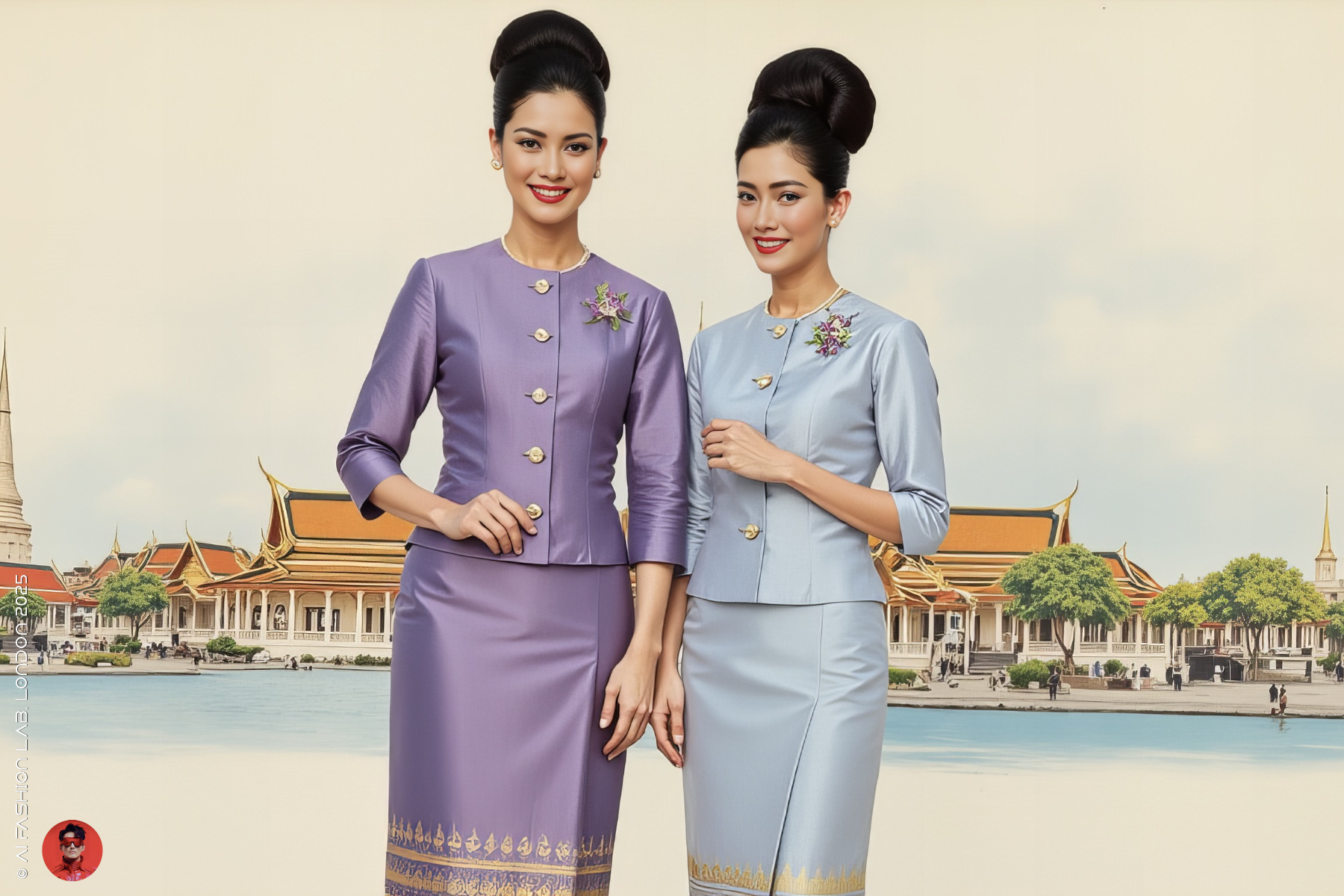ฝึก AI ให้รู้จักทรงผมสไตล์ไทยยุค 1960s ในชุดไทยเรือนต้น
ฝึก AI ให้รู้จักทรงผมสไตล์ไทยยุค 1960s ในชุดไทยเรือนต้น
สวัสดีครับ วันนี้มีเพื่อนๆ หลายคน ถามเข้ามาทางเพจว่า ชื่นชอบคอลเล็คชั่นชุดไทยเรือนต้นที่เป็นแบบ 1960s โดยเฉพาะทรงผมต่างๆในสไตล์ 1960s ซึ่งดูแล้วน่ารักและชวนให้นึกถึงความสง่างามของสุภาพสตรีไทยในยุคนั้น ผมจึงอยากมาเล่าเบื้องหลังการทำงานของผมที่ใช้ AI เพื่อสร้างสรรค์ผลงานคอลเลกชันนี้ให้ทุกคนได้อ่านกันครับ
ขั้นตอนแรก: ฝึก LoRA และพบปัญหาเรื่อง “ทรงผมซ้ำซาก”
เมื่อผมฝึกโมเดล LoRA สำหรับคอลเลกชันนี้ในครั้งแรก ผมพบว่าชุดข้อมูลที่ผมใช้มีทรงผมเพียงไม่กี่แบบ ส่วนใหญ่เป็น ทรงเกล้ามวยสูง (high chignon) ที่พบได้บ่อยในงานพิธีต่างๆ แม้ว่าผมจะพยายามใส่คำกำกับทรงผม 1960s เข้าไปในพรอมต์ก็ตาม ผลลัพธ์ที่ได้ก็ยังคงออกมาคล้ายๆ กันหมด นั่นทำให้ภาพดูซ้ำและขาดความน่าสนใจ
แม้แต่ระบบปิดอย่าง Midjourney หรือ Google Imagen ก็ยังมีข้อจำกัดด้าน “ความแม่นยำของทรงผม”
แม้ว่าแพลตฟอร์ม AI อย่าง Midjourney หรือ Google Imagen จะสามารถสร้างภาพที่ให้ "บรรยากาศโดยรวม"ของยุค 1960s ได้ แต่ในแง่ของ ทรงผมเฉพาะเจาะจง เช่น bouffant, flipped bob, หรือ beehive นั้น ผลลัพธ์มักยังคงเป็นเพียงการตีความกว้าง ๆ มากกว่าการสร้างสรรค์ที่ตรงเป๊ะตามประวัติศาสตร์แฟชั่น
นั่นจึงเป็นเหตุผลที่ผมหันมาใช้ การฝึกโมเดล LoRA แบบเฉพาะทาง เพื่อให้สามารถ ควบคุมและกำกับรายละเอียดได้อย่างแม่นยำยิ่งขึ้น
ขั้นตอนที่สอง: เริ่มต้นใหม่ด้วยความคิดสร้างสรรค์
ผมจึงตัดสินใจเริ่มต้นใหม่ โดยตั้งเป้าว่าต้องการให้ AI เรียนรู้ทรงผมที่ หลากหลายและตรงกับยุค 1960s ให้ได้มากที่สุด ผมเริ่มจากการค้นคว้าในอินเทอร์เน็ตถึงทรงผมที่ได้รับความนิยมในยุคนั้น ซึ่งทรงผมที่ผมหยิบมาใช้เป็นต้นแบบ มีหลากหลายสไตล์ เช่น
Bouffant – ทรงผมพองสูงด้านบน มักม้วนปลายผมออกเล็กน้อย
Beehive – เกล้าผมให้สูงคล้ายรังผึ้ง
Flipped Bob – ทรงผมบ๊อบสั้นปลายกระดกออกด้านนอก
Sleek Half-Up – ปล่อยผมครึ่งหนึ่งและยีผมด้านบนให้พอง อาจคาดผมหรือไม่ก็ได้
Curled Short Bob – ทรงผมสั้นที่ม้วนเป็นลอนแน่น
Soft Curls with Bangs – ลอนอ่อนๆ กับหน้าม้าดูอ่อนเยาว์
ขั้นตอนที่สาม: ปรับภาพต้นฉบับให้เข้ากับฐานข้อมูล
อุปสรรคสำคัญคือ ภาพอ้างอิงส่วนใหญ่ที่พบทางอินเทอร์เน็ตมักเป็นภาพของชาวตะวันตกที่มีผมสีทองหรือสีน้ำตาลอ่อน ขณะที่ LoRA ของผมนั้นออกแบบมาให้สร้างภาพของหญิงไทยที่มี ผมสีดำ ซึ่งเป็นสีผมพื้นฐานในวัฒนธรรมไทย
ผมจึงแก้ปัญหานี้ด้วยการใช้โปรแกรม Flux Kontext Max เพื่อสั่งให้ AI ทำการเปลี่ยนสีผมในภาพต้นฉบับให้เป็นสีดำ จากนั้นจึงใช้ FaceSwap เปลี่ยนใบหน้าให้เป็นใบหน้าของหญิงสาวไทย
หลายคนอาจสงสัยว่า ทำไมไม่ใช้ AI เปลี่ยนเป็นหน้าคนเอเชียไปเลย?
คำตอบคือ แม้จะทำได้ แต่เมื่อ AI เปลี่ยนใบหน้า มักจะเปลี่ยนทรงผมไปด้วย ซึ่งผมต้องการ รักษาทรงผมดั้งเดิมไว้ อย่างแม่นยำ ดังนั้นการใช้ FaceSwap ทีหลังจึงเป็นทางเลือกที่แม่นยำกว่า และผมสามารถเลือกนางแบบได้ตามต้องการ
ขั้นตอนที่สี่: กำกับชื่อทรงผมและรายละเอียดในภาพ
เมื่อได้ภาพใหม่แล้ว ผมจะใส่ข้อมูลกำกับในแต่ละภาพ เช่น
ชื่อของทรงผม
คำอธิบายลักษณะผม (เช่น “bouffant with soft curls”, “half-up with yellow headband” ฯลฯ)
รายละเอียดแฟชั่น เช่น "ชุดไทยเรือนต้นกับผ้าซิ่นลายริ้วพาสเทล"
ภาพพื้นหลัง ที่สอดคล้องกับยุค 1960s ในบริบทไทย เช่น วัด ดอกไม้ ฉากราชสำนัก เป็นต้น
สิ่งเหล่านี้ช่วยให้ AI เข้าใจทั้งรูปแบบทรงผม บรรยากาศ และบริบทของแฟชั่นได้ดียิ่งขึ้น
ขั้นตอนที่ห้า: ยกระดับคุณภาพของภาพต้นฉบับ
ก่อนจะนำภาพเหล่านี้ไปฝึกโมเดล ผมใช้เครื่องมือต่างๆ เพื่อ เพิ่มความคมชัดและขนาดของภาพ ให้ AI ได้เรียนรู้จากภาพคุณภาพสูงสุด และสามารถสร้างภาพออกมาได้คมชัด รายละเอียดครบ
เมื่อฝึก LoRA รุ่นที่สองเสร็จแล้ว ผมสามารถใส่พรอมต์ให้ AI สร้างทรงผมหลายแบบตามต้องการได้ และผลลัพธ์ที่ออกมาก็น่ารัก สนุก และแม่นยำตามยุค 1960s จริงๆ
💡 เคล็ดลับสำหรับคนที่กำลังฝึก LoRA ด้านแฟชั่น:
ภาพต้องคมชัด ชัดเจน และไม่เบลอ
ใส่ข้อมูลกำกับอย่างละเอียด (ชื่อทรงผม ลักษณะ ฯลฯ)
สีผมต้องสอดคล้องกับบริบทของแฟชั่น
หากต้องเปลี่ยนหน้า ให้พิจารณาแยกขั้นตอนจากทรงผม
AI เป็นเครื่องมือสร้างสรรค์ที่ทรงพลัง แต่ความสำเร็จของมันขึ้นอยู่กับ “ความใส่ใจและวิธีคิดของเรา” ครับ
หวังว่าเคล็ดลับนี้จะเป็นประโยชน์ และขอให้ทุกคนสนุกกับการสร้างสรรค์ทรงผมสวยๆ ในสไตล์วินเทจกันนะครับ! 💕✨
Training AI to Recognise 1960s Thai Hairstyles in “Chud Thai Ruean Ton” Fashion
1960s Thai Hairstyles and AI Creativity: A Behind-the-Scenes Look at My LoRA Training
Hello everyone! I’ve received several questions through my page about my latest AI-enhanced collection featuring 1960s-inspired “chut thai ruean ton”—particularly the vintage hairstyles that many of you love.
Let’s talk a bit about how I brought those looks to life using AI.
When I first trained my LoRA model for this collection, I noticed that my dataset only included a couple of hairstyles—mostly the classic high chignon (a sleek, voluminous bun worn high on the crown). So despite prompting with different hairstyle names from the 1960s, the AI kept producing similar images with the same updo. It was a bit… boring.
Even closed systems like Midjourney or Google Imagen still have limitations when it comes to hairstyle accuracy.
While AI platforms like Midjourney or Google Imagen can produce images that capture the overall "vibe" or atmosphere of the 1960s, when it comes to specific hairstyles—such as bouffants, flipped bobs, or beehives—the results often remain broad interpretations rather than historically accurate recreations based on real fashion trends.
So I started over—with creativity in mind.
Step 1: Research 1960s Hairstyles
I began by researching various popular 1960s hairstyles on the internet. Some key styles I looked for included:
Bouffant – a voluminous puff at the crown, often paired with flipped ends.
Beehive – piled high and rounded like a hive.
Flipped Bob – curled outward at the ends, sometimes paired with bangs.
Sleek Half-Up – hair teased at the crown but left flowing, with or without a headband.
Curled Short Bob – with set waves and structured shape.
Soft Curls with Bangs – romantic and more youthful.
But there was one challenge: most of the reference photos I found featured Western women with light-coloured hair, while my fashion LoRA was designed around Thai women with black hair.
Step 2: Colourisation and Face Swapping
To solve this, I used Flux Kontext Max to recolour the hair in the vintage photos to black. Then, using FaceSwap, I replaced the original faces with Thai models to match the aesthetic of my dataset.
You might wonder: why not just change the face to Asian using AI directly?
The answer is: yes, it’s technically possible, but in most cases, changing the face also affects the hairstyle—and that’s something I wanted to preserve exactly. So face-swapping after recolouring gave me full control.
Step 3: Annotate Your Dataset
As I built this new dataset, I carefully annotated each image with:
The name of the hairstyle
A brief description (e.g. “bouffant with soft curls,” “sleek half-up with yellow headband,” etc.)
Fashion details like “chud thai ruean ton with pastel striped sinh”
Backgrounds consistent with the Thai 1960s theme—temples, floral motifs, architecture.
This helped the AI learn not just the shape of the hairstyle, but the full context: the clothes, background, and aesthetic.
Step 4: High-Quality Inputs
Before training, I made sure that all images were upscaled, enhanced, and cleaned, so that the model would learn from the best possible data. This really made a difference in the quality of the generated results.
Once the second LoRA was trained, I could finally prompt various hairstyles—and the AI responded beautifully, giving me a variety of fun, cute, and accurate 1960s styles.
💡 Tip: If you’re creating your own fashion LoRA, don’t underestimate the importance of:
Clear image annotation
Hair colour consistency
Face preservation vs. face identity
Diverse references—even if you need to adapt them!
AI is a fantastic creative tool, but it still needs you to guide it with thought, research, and vision.
I hope you find these tips helpful and enjoy creating wonderful hairstyles from the past! 💕✨
#aifashionlab #AI #aiartist #aiart #aifashion #aifashiondesign #aifashionstyling #aifashiondesigner #fashion #fashionhistory #historyoffashion #fashionstyling #fashionphotography #digitalfashion #digitalfashiondesign #digitalcostumedesign #digitaldesign #digitalaiart #ThaiFashionHistory #ThaiFashionAI #thailand #UNESCO

























